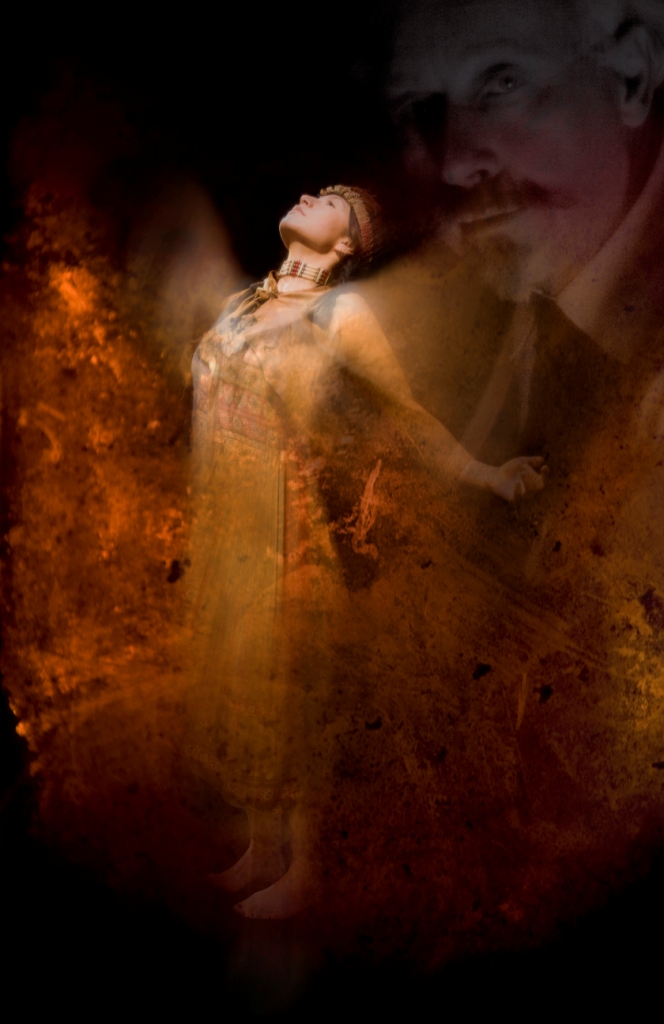The Edward curtis Project: images that haunt and define

Witnessing has its costs, its collateral damage. Artists run the risk of vicarious traumatization, but being forced to look is a far different act than forcing a look. This distinction is made between a present-day Métis journalist, Angeline, and the 19th Century photographer, Edward Curtis.
The Edward Curtis Project, currently on at Presentation House as part of the PuSh Festival, is a phenomenal piece of contemporary theatre with an impressive ensemble cast. Written and directed by Marie Clements and co-directed by Brenda Leadlay, the multi-media production is staged like a life-sized, three-dimensional photo album that honours family lineage and allows for its dysfunction.
The round stage is encircled by screens that are only visible when lit with projections of photographs — images that haunt and define the lives of characters. Angeline interacts with pictures, inhabits portraits and empowers a sepia-toned image with her voice. The stage design (Tim Matheson, Andreas Kahre) is imaginative and effective, bridging scenes and opening characters to other dimensions where they interface with the past. Lighting (design by John Webber) and sound (design by Bruce Ruddell) play integral roles.
The effect is a cohesive and highly textural experience. Beautiful thanks to the visuals; tragic because of society’s power imbalances and certain casualties.
Angeline (Tamara Podemski) steps into a picture and onto a beach in Puget Sound. We see her hunched over in profile, digging for clams. We see this figure through Edward Curtis’s lens: an Indian Princess, the daughter of Si’ahl — Seattle. It’s his first photograph and Curtis (Stephen E. Miller) is thrilled to have successfully bartered the shot. For her part, the princess is happy to eat. The Vanishing Indian is the title of his life’s work.
Back in the present, Angeline holds the coffee-table version. “Finally a darkness with my name on it,” she says. After all, according to the amateur ethnographer, it’s her indigenous past that has vanished.
Curtis is obsessed with the romanticism of a beautiful death. So driven to memorialize entire indigenous societies, he imposes his own criteria — deciding what authentic looks like and fixing the image in perpetuity. His drive to capture a photograph is an equal drive to possess its subject. Like his colonial predecessors, he doesn’t question his sense of entitlement to look and therefore to own. He sacrifices his marriage in the name of art, and the playwright suggests his ultimate quest is to understand enough that he might belong.
“People that are close to me call me Chief,” Curtis says as he cooks breakfast for Angeline.
“Aren’t you going to ask me what I call myself,” she asks and introduces Curtis to her boyfriend, Yiska (Kevin Loring): “They call him Chief.”
“Ah,” reasons Curtis, “a pet name?”
“No. Because he is one.”
Clements’s writing is clever, nuanced, uses historical fact like a barb and racism like an even sharper weapon.
“I know someone who looks like you,” Curtis tells Yiska.
“It’s OK — we all look the same.”
Edward Curtis’s fatal flaw was also the passion driving his work. He lived and died by his artistic vision to photograph —to catch, confine and define — the Native American Indian before all were exterminated in the crush of civilization, enlightened thought, smallpox-infested blankets and residential schools. Curtis toured the American frontier with the technology to help him see but not necessarily understand.
In contrast, Angeline’s profession also demands that she see and, maybe, understand. As reporter sent on assignment, the three young faces she uncovers aren’t frozen in a camera’s flash, but frozen in the frostbitten tundra of the North. How does she report the truth? Are these three girls who died in the cold? Or are these three girls whose father, drunk and isolated, left for a neighbour’s because he had no phone, no heat and nothing to feed his sick child? How is she connected to their death? When she reports this news to the world, how will she frame their death. Angeline asks questions Curtis is not capable of asking and it compromises her mental stability.
The corpses’ cheeks are rosy with life. Devastated by the beauty, Angeline knows their short lives lacked the romance and stoicism Curtis sought. Yet their very lives exposed the arrogance and ignorance of his conclusion: vanishing.
The Edward Curtis Project is performed in tandem with a photographic exhibit by Rita Leistner. Her subjects posed for two images, choosing ceremonial or traditional regalia for one image and daily street clothes like snow pants and ball caps for the second — a comment on the dualities and dynamic existence of First Nations, Métis and Inuit life.
The Edward Curtis Project runs until January 31 at Presentation House as part of the PuSh Festival. For more information go here.
For more information on the production why not listen to this interview with Stephen E. Miller which originally aired on CJSF - FM. Thanks to Frieda Werden.



